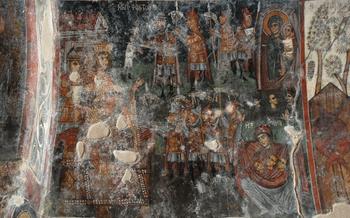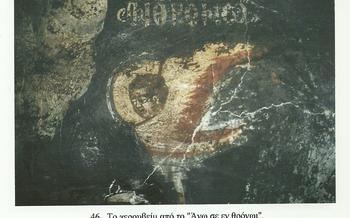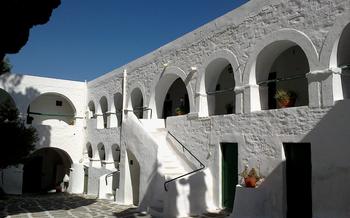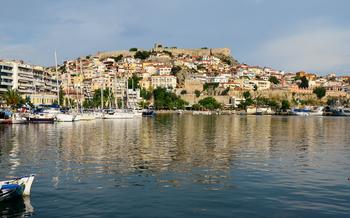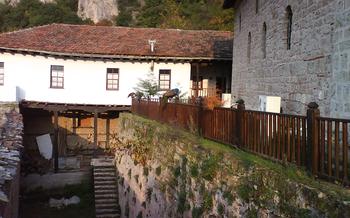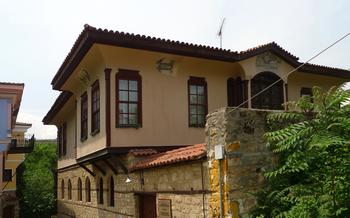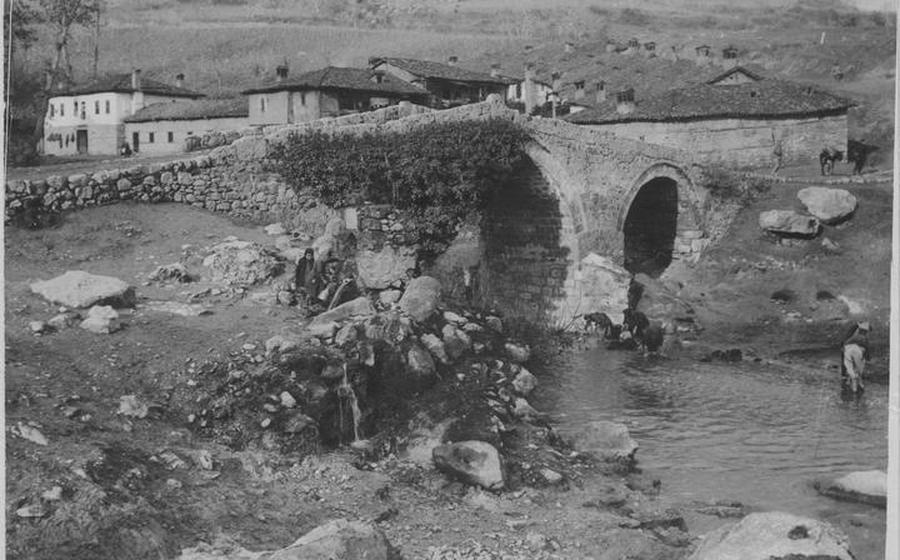
Asomatos Monastery
- Historical Background: An Ancient Abode of Faith
- Religious Significance
- Stunning Architecture
- The Holy Relic
- Monastic Life
- Tranquil Surroundings
- Cultural Heritage
- Pilgrimage and Tourism
- Festivals and Celebrations
- Local Delicacies
- Souvenirs and Handicrafts
- Visiting Hours and Dress Code
- Getting There
- Guided Tours and Audio Guides
- Insider Tip:
Historical Background: An Ancient Abode of Faith
Nestled amidst the picturesque landscape of Veria, Greece, the Asomatos Monastery stands as a testament to centuries of religious devotion and architectural grandeur. Founded in the 10th century, the monastery has witnessed a rich tapestry of historical events, evolving into a spiritual beacon for Orthodox Christians and a treasure trove of Byzantine art.
The monastery's origins can be traced back to the pious Emperor Constantine VII Porphyrogenitus, who is believed to have commissioned its construction. Over the years, it underwent several renovations and expansions, reflecting the evolving architectural styles and the devotion of successive generations of monks.
Asomatos Monastery boasts a unique blend of Byzantine and post-Byzantine architectural elements. Its exterior features intricate stonework, graceful arches, and decorative domes, while the interior is adorned with stunning frescoes and mosaics that narrate biblical stories and the lives of saints. The monastery's serene courtyards, adorned with lush gardens and vibrant flowers, provide a tranquil sanctuary for contemplation and prayer.
Religious Significance
The Asomatos Monastery holds profound spiritual importance within the Orthodox Christian tradition, serving as a sacred site of pilgrimage and devotion. It is revered as a place of deep religious significance, attracting countless pilgrims and visitors seeking spiritual enlightenment and connection with their faith. The monastery's holy relics, particularly the Holy Relic, are believed to possess miraculous powers and attract pilgrims from far and wide who come to pay homage and seek divine blessings. The monastery has played a pivotal role in preserving and transmitting Orthodox Christian traditions and practices, contributing significantly to the region's religious heritage. Throughout its history, the Asomatos Monastery has been a sanctuary for spiritual seekers, offering solace, guidance, and a deep sense of communion with the divine.
Stunning Architecture
The Asomatos Monastery stands as a testament to the exquisite craftsmanship and artistic brilliance of its builders. Its exterior design draws inspiration from Byzantine architectural traditions, featuring intricate stonework, arched windows, and a majestic dome that crowns the central structure. The exterior walls are adorned with blind arches and decorative friezes, lending a sense of grandeur to the monastery's facade.
Stepping inside the monastery, visitors are greeted by a breathtaking display of frescoes and mosaics that adorn the walls and ceilings. These intricate artworks depict biblical scenes, saints, and angels, each brushstroke imbued with religious symbolism and iconography. The vibrant colors and expressive figures bring the stories of the scriptures to life, creating an immersive experience for the faithful.
The monastery's artwork is not merely decorative but serves a profound spiritual purpose. It acts as a visual aid, guiding the faithful in their prayers and meditations. The symbolism and iconography embedded in the frescoes and mosaics convey theological concepts, moral lessons, and the lives of the saints, inspiring visitors to reflect on their own spiritual journeys.
The harmonious blend of architectural elements and religious artwork at the Asomatos Monastery creates a sacred space that invites contemplation and devotion. It is a place where the beauty of art and the depth of faith intertwine, offering visitors a profound and awe-inspiring experience.
The Holy Relic
The Asomatos Monastery is home to a revered holy relic, which holds immense significance for both pilgrims and visitors alike. According to legend, this relic is believed to be a fragment of the True Cross on which Jesus Christ was crucified. The story surrounding the relic is awe-inspiring and has become an integral part of the monastery's history and spiritual allure.
It is said that in the early days of Christianity, a devout monk named Agathon was traveling through the Holy Land when he stumbled upon a fragment of the True Cross. Filled with reverence and awe, he carefully collected the relic and brought it back to the Asomatos Monastery. Since then, the fragment has been preserved and venerated within the monastery's sacred spaces, attracting pilgrims and visitors from far and wide.
The Holy Relic is not only a symbol of the monastery's enduring faith but also a testament to the power of devotion and the enduring legacy of Jesus Christ. Pilgrims flock to the monastery to pay homage to the relic, seeking spiritual guidance, blessings, and a connection to the divine. The relic's presence has transformed the Asomatos Monastery into a place of profound spiritual significance, where visitors can experience a deep sense of reverence and connection to their faith.
Monastic Life
Within the Asomatos Monastery, the daily rhythm of monastic life unfolds in harmony with ancient traditions. The monks and nuns, dedicated to a life of devotion, follow a strict routine that revolves around prayer, work, and contemplation. Their days begin at dawn with morning prayers, invoking divine blessings upon their community and the world. As the sun rises, they engage in various tasks, tending to the monastery's needs, such as gardening, cooking, and maintaining the premises.
Prayers punctuate their day, creating a sacred rhythm that permeates the monastery's atmosphere. In the tranquility of the chapel, they gather to offer heartfelt supplications, seeking guidance, strength, and spiritual nourishment. Evenings are dedicated to introspection and reflection, as they gather for evening prayers, seeking solace and renewal before retiring to their humble cells.
The monks and nuns of Asomatos Monastery are custodians of a rich spiritual heritage. They preserve ancient traditions, ensuring that the monastery remains a beacon of faith and devotion for generations to come. Their lives exemplify the essence of monasticism, demonstrating the transformative power of surrendering to a higher calling and finding solace in the simplicity of a life dedicated to God.
Tranquil Surroundings
Amidst the bustling streets of Veria, the Asomatos Monastery offers an oasis of serenity and tranquility. Nestled amidst lush greenery and towering trees, the monastery exudes an aura of peace and spirituality. Visitors are immediately captivated by the natural beauty that envelops the site. The monastery's gardens and courtyards are a testament to the monks' dedication to preserving the environment and creating a harmonious blend of nature and spirituality.
The courtyards, adorned with vibrant flowers and aromatic herbs, provide a tranquil setting for contemplation and reflection. The gentle rustling of leaves and the sweet chirping of birds create a symphony of nature that soothes the soul. Visitors can wander through the gardens, marveling at the variety of plants and their symbolic meanings within the Orthodox tradition. The serene atmosphere invites visitors to slow down, embrace the present moment, and connect with the divine.
The Asomatos Monastery is a place where the natural world and the spiritual realm converge, offering visitors a unique opportunity to experience the beauty of creation and the profound peace that comes from within.
Cultural Heritage
The Asomatos Monastery is not only a religious sanctuary but also a treasure trove of cultural heritage. Within its walls, visitors can discover a collection of historical artifacts, relics, and artwork that span centuries. The monastery's museum houses a diverse array of Byzantine and post-Byzantine icons, manuscripts, vestments, and other ecclesiastical objects. These artifacts provide a glimpse into the rich history and traditions of the Orthodox Christian faith.
The monastery is renowned for its stunning collection of frescoes and mosaics. The walls of the church and other buildings are adorned with vibrant and intricate artwork depicting biblical scenes, saints, and historical figures. These masterpieces serve as a testament to the skill and devotion of the artists who created them. The symbolism and iconography in the artwork invite visitors to contemplate the deeper spiritual meanings and messages conveyed.
The Asomatos Monastery is a living testament to the enduring legacy of Byzantine and post-Byzantine art. Its collection of cultural treasures contributes significantly to the region's cultural identity. Preserving and showcasing these artifacts ensures that future generations can appreciate and learn from the rich artistic heritage of the monastery.
Pilgrimage and Tourism
The Asomatos Monastery is not just a place of worship but also a significant pilgrimage site. Many Orthodox Christians from Greece and beyond visit the monastery to seek spiritual guidance, offer prayers, and venerate the holy relic. The monks and nuns at the monastery are welcoming and accommodating to visitors, providing guidance and assistance to pilgrims.
For tourists, the Asomatos Monastery offers a unique glimpse into the religious and cultural heritage of Greece. Guided tours are available in different languages, allowing visitors to learn about the history, architecture, and spiritual significance of the monastery. Visitors can also explore the monastery's gardens, courtyards, and chapels at their own pace using audio guides.
The monastery provides basic facilities and services for pilgrims and tourists, including a guesthouse, a dining area, and a gift shop. The guesthouse offers simple but comfortable accommodations for those who wish to stay overnight and immerse themselves in the serene atmosphere of the monastery. The dining area serves traditional Greek cuisine prepared with fresh, locally sourced ingredients.
The Asomatos Monastery is a place where history, spirituality, and natural beauty converge. It is a must-visit destination for anyone interested in exploring the rich cultural and religious heritage of Greece.
Festivals and Celebrations
The Asomatos Monastery is not only a place of spiritual devotion but also a center of cultural and community celebrations. Throughout the year, the monastery hosts several religious festivals and events that draw pilgrims and visitors from near and far. These events provide a unique opportunity to experience the rich traditions and customs of the Orthodox Christian faith.
One of the most significant festivals is the annual celebration of the monastery's patron saint, Saint Asomatos. This event takes place in August and features a series of religious services, processions, and communal feasts. Pilgrims from across the region flock to the monastery to pay homage to the saint and seek his blessings.
Other notable festivals include the Feast of the Holy Cross in September, which commemorates the discovery of the True Cross, and the Feast of the Presentation of the Theotokos in November, which celebrates the presentation of the Virgin Mary in the Temple. Each festival is marked with special rituals, hymns, and prayers, offering visitors a glimpse into the vibrant spiritual life of the monastery.
During these celebrations, the monastery's courtyard transforms into a lively gathering place, filled with music, dance, and traditional Greek cuisine. Visitors can savor delicious local delicacies, enjoy folk performances, and immerse themselves in the warm hospitality of the monastic community.
Participating in these festivals is a truly enriching experience that allows visitors to connect with the local culture, celebrate the Orthodox Christian faith, and create lasting memories of their time at the Asomatos Monastery.
Local Delicacies
The Asomatos Monastery offers visitors an authentic taste of traditional Greek cuisine, prepared with fresh, locally sourced ingredients and infused with the flavors of monastic life. The monastery's kitchen is renowned for its slow-cooked stews, freshly baked bread, and exquisite pastries. Visitors can savor delectable dishes such as moussaka, pastitsio, and gemista, all prepared with the finest seasonal produce. The monastery's unique culinary creations, handed down through generations of monks, reflect the rich cultural heritage of the region.
For those seeking a truly immersive experience, the monastery offers the opportunity to partake in traditional Greek cooking classes. Under the guidance of experienced monks or nuns, visitors can learn the secrets of preparing authentic Greek dishes, using the freshest local ingredients and traditional techniques. These classes provide an unforgettable culinary journey, allowing visitors to not only savor the flavors of the region but also gain insights into the monastic way of life.
Souvenirs and Handicrafts
Within the Asomatos Monastery, visitors will find a variety of shops offering a range of religious items and locally crafted souvenirs. These shops serve as a source of income for the monastery, helping to support its maintenance and upkeep.
Pilgrims and visitors can purchase religious icons, candles, and prayer books as mementos of their visit. Additionally, they can find unique handicrafts and souvenirs made by local artisans, such as pottery, jewelry, and textiles. These items often incorporate traditional Greek designs and motifs, making them a cherished reminder of the region's rich cultural heritage.
By purchasing these souvenirs and handicrafts, visitors not only take home a piece of the monastery's spirit but also contribute to the preservation of its sacred spaces and the continuation of its traditions.
Visiting Hours and Dress Code
When visiting the Asomatos Monastery, it is essential to adhere to the appropriate dress code and behavior expected in such a sacred space. Visitors should dress modestly and respectfully, avoiding revealing or overly casual attire. Shorts, tank tops, and beachwear are generally not considered suitable. For women, it is customary to cover their heads with a scarf or headscarf as a sign of reverence.
Upon entering the monastery, visitors are expected to maintain a respectful and quiet demeanor. Loud conversations, boisterous behavior, or disruptive activities are discouraged. Photography is generally permitted, but it is essential to be mindful of the privacy of the monks and nuns and to refrain from taking pictures during religious services or in areas designated as private.
The monastery is open to visitors daily, with specific hours designated for visiting. It is advisable to check the official website or inquire with local tourism offices for the most up-to-date information regarding visiting hours, as they may vary depending on the season or special events.
Getting There
The Asomatos Monastery is conveniently located in the town of Veria, Greece, making it easily accessible for pilgrims and tourists alike. If you're traveling by public transportation, you can take a bus from Thessaloniki, the nearest major city, which will take approximately 1 hour and 30 minutes. Alternatively, if you prefer a more scenic route, you can take a train from Thessaloniki to Veria, which offers breathtaking views of the countryside and takes about 2 hours.
Once you arrive in Veria, you can either take a taxi or catch a local bus to the monastery, as it is situated just a few kilometers outside the city center. For those driving their own vehicles, the monastery provides ample parking space, ensuring a hassle-free visit. To enhance your journey, keep an eye out for landmarks along the way, such as the Veria Clock Tower or the Archaeological Museum of Veria, which offer insights into the region's rich history and culture.
Guided Tours and Audio Guides
To enhance your visit, consider taking advantage of the guided tours available at the Asomatos Monastery. Knowledgeable and passionate guides will lead you through the monastery's sacred spaces, shedding light on its history, architecture, and religious significance. Tours are conducted in various languages, ensuring that visitors from all backgrounds can fully appreciate the monastery's treasures.
For those who prefer a more independent exploration, audio guides are available in multiple languages. Equipped with an audio guide, you can wander at your own pace, immersing yourself in the monastery's rich history and symbolism. The audio guides provide detailed commentary on the monastery's highlights, offering a comprehensive and informative experience.
Whether you opt for a guided tour or an audio guide, you'll gain a deeper understanding of the Asomatos Monastery's spiritual and cultural significance. These resources will enrich your visit, leaving you with a lasting impression of this remarkable Byzantine treasure.
Insider Tip:
Beyond the main attractions, the Asomatos Monastery holds a few hidden gems waiting to be discovered. One secret spot is the secluded courtyard behind the refectory, where visitors can find a serene oasis amidst the monastery's bustling activity. Surrounded by lush greenery and adorned with intricate frescoes, this hidden haven offers a tranquil retreat for contemplation and reflection.
Another insider tip is to visit the monastery during the annual feast day celebrations. These events, typically held in September, showcase the vibrant traditions and customs of the region. Visitors can witness colorful processions, enjoy traditional music and dance performances, and savor delicious local delicacies prepared by the monks themselves. Participating in these festivities offers an immersive experience of the monastery's rich cultural heritage and the warmth of the local community.

